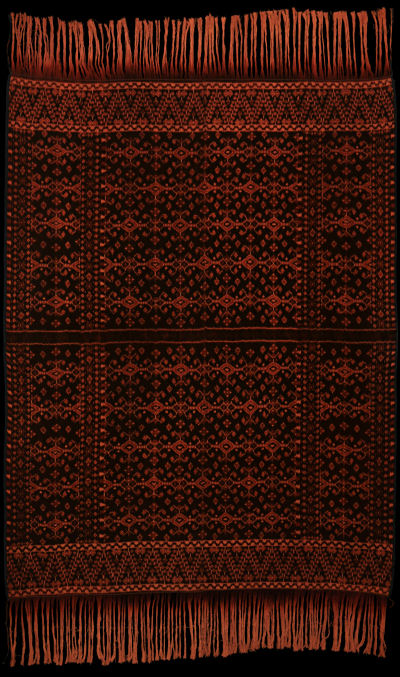| |
 
 | | | |
083 Flores Group, Ndona
Semba (man's shawl) 
| | Locale: | Village not identified. | | Period: | 1935-1950 | | Yarn: | Cotton, hand-spun, fine | | Technique: | Warp ikat | | Panels: | 2 | | Size: | 114 x 171 cm (3' 8" x 5' 7") LW: 1.50 | | Design: | Patola inspired blanket of a type called semba mosalaki with ten rows and six columns of what appear to be jilamprang motifs, but are probably linked genealogical figures, and intricate tumpal borders. The mosalaki, 'Lords of the Earth', are the region's nobility. Two shades of morinda red, one almost pink, the other dark. Overall tonality is aubergine. To quote Hunt Kahlenberg on nearly identical cloth: 'The large lozenges appear to float on a plane above the intricate detailing that vibrates around them and visually pulls them back into the piece.' | | Comment: | Outstanding example of the type - one of the best of the few examples known through publication. Patola-influence is strong, but according to Maxwell (see Literature below) the main motif may well represent the genealogical motif found across Southeast Asia. Perhaps an example of syncretic patterning. Tight weaving. Cloth shows signs of age, but no fading or fraying. | | Background: | Chapters on Flores Group and Ndona. | | Published: | Ikat Textiles of the Indonesian Archipelago, 2018.
| | Compare: | 084 090 | | Sources: | Nearly identical to early 20th C. semba in Australian National Gallery, Nr. 1980.1656, depicted in Maxwell, Textiles of Southeast Asia. Fig. 181. Nearly identical to semba (only identified as 'Flores') in Hunt Kahlenberg, Textile Traditions of Indonesia, Fig. 51. Similar to cloth depicted in Khan Majlis, Woven Messages, Fig. 167, identified as Endeh (Ende), which was almost certainly made in the Endenese part of Ndona. A very similar cloth is worn by a village elder on a photograph illustrating Kent Watters's contribution to the same book, Page 89. Similar to one depicted in Hamilton's contribution to Nabholz-Kartaschoff, Weaving Patterns of Life, Fig. 4; and to one in Hamilton, Gift of the Cotton Maiden, Fig. 6-21. | | |

©Peter ten Hoopen, 2024
All rights reserved.
|
|


